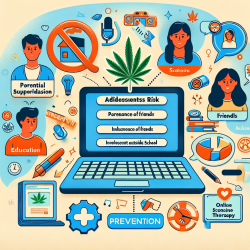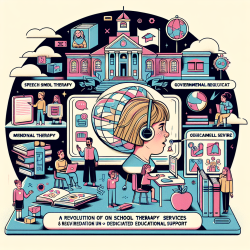Understanding Adolescent Cannabis Use: Key Findings and Practical Applications
As a practitioner dedicated to improving the lives of children, it's crucial to stay informed about the latest research on adolescent behavior. A recent study titled Perceived risk of harm from monthly cannabis use among US adolescents: National Survey on drug Use and Health, 2017 provides valuable insights into the factors that influence adolescents' perceptions of cannabis use. This blog will break down the key findings and offer practical applications to enhance your practice.
Key Findings from the Study
The study analyzed data from the 2017 National Survey on Drug Use and Health (NSDUH) and found that:
- 80% of adolescents perceived some risk of harm from monthly cannabis use.
- Parental monitoring, peer attitudes, school importance, and extracurricular activities were significant factors influencing this perception.
- Adolescents with high parental monitoring, positive peer attitudes towards cannabis, high school importance, and participation in extracurricular activities were more likely to perceive cannabis use as risky.
Practical Applications for Practitioners
Based on these findings, here are some strategies you can implement to improve outcomes for adolescents:
1. Enhance Parental Monitoring
Encourage parents to be more involved in their children's lives, especially in monitoring their activities. Simple actions like limiting time out with friends on school nights can significantly impact adolescents' perceptions of risk.
2. Leverage Peer Influence
Peer attitudes play a crucial role in shaping adolescents' behaviors. Encourage positive peer interactions and create programs that promote peer disapproval of cannabis use. Peer education interventions have shown promise in changing attitudes and behaviors.
3. Promote School Engagement
Adolescents who find their schoolwork meaningful are less likely to engage in risky behaviors. Work with schools to make the curriculum more engaging and relevant to students' lives.
4. Encourage Extracurricular Activities
Participation in extracurricular activities provides a structured environment that can deter substance use. Promote involvement in school-based, community-based, or faith-based activities.
Encouraging Further Research
While this study provides valuable insights, there is always room for further research. Consider conducting longitudinal studies to monitor trends in risk perceptions and consumption. Analyzing data by state can also provide insights into the effects of different cannabis laws on adolescent behavior.
For a deeper dive into the research, you can read the original paper here: Perceived risk of harm from monthly cannabis use among US adolescents: National Survey on drug Use and Health, 2017.
Conclusion
Understanding the factors that influence adolescents' perceptions of cannabis use is crucial for developing effective prevention programs. By enhancing parental monitoring, leveraging peer influence, promoting school engagement, and encouraging extracurricular activities, we can help adolescents make informed decisions about substance use. Let's work together to create a safer and healthier future for our children.










